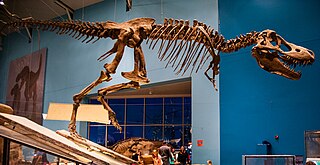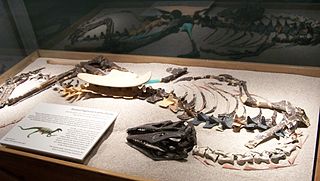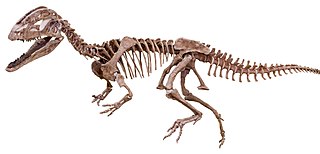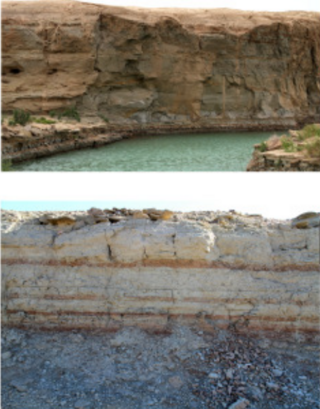
Tarbosaurus is a genus of tyrannosaurine theropod dinosaur that lived in Asia about 72 million years ago to 68 million years ago, during the Maastrichtian age at the end of the Late Cretaceous period, considered to contain a single known species: Tarbosaurus bataar. Fossils have been recovered from the Nemegt Formation of Mongolia, with more fragmentary remains found further afield in the Subashi Formation of China.

Coeluridae is a historically unnatural group of generally small, carnivorous dinosaurs from the late Jurassic Period. For many years, any small Jurassic or Cretaceous theropod that did not belong to one of the more specialized families recognized at the time was classified with the coelurids, creating a confusing array of 'coelurid' theropods that were not closely related. Although they have been traditionally included in this family, there is no evidence that any of these primitive coelurosaurs form a natural group with Coelurus, the namesake of Coeluridae, to the exclusion of other traditional coelurosaur groups.

Crichtonsaurus is a genus of herbivorous ankylosaurid dinosaur that lived during the Late Cretaceous in what is now China. It was named after Michael Crichton, the author of the dinosaur novel Jurassic Park. A sister taxon was discovered, C. benxiensis, which is now identified as a separate genus.

Wuerhosaurus is a genus of stegosaurid dinosaur from the Early Cretaceous Period of China and Mongolia. As such, it was one of the last genera of stegosaurians known to have existed.

Xinjiangovenator is a genus of coelurosaurian dinosaurs, possibly part of the group Maniraptora, which lived during the Early Cretaceous period, sometime between the Valanginian and Albian stages. The remains of Xinjiangovenator were found in the Lianmuqin Formation of Wuerho, Xinjiang, China, and were first described by Dong Zhiming in 1973. The genus is based on a single specimen, an articulated partial right lower leg, containing the tibia, three pieces of the fibula, the calcaneum and the astragalus. This specimen, IVPP V4024-2, is the holotype of the genus.

Asiatosaurus is an extinct genus of herbivorous sauropod dinosaur which lived during the Early Cretaceous in Mongolia and China. The type species is known only from teeth, making it difficult to rely on information until more specimens are found to expand our knowledge, and another species is known, also based on scant remains; both are now classified as nomina dubia.
Tugulusaurus is a genus of coelurosaurian theropod dinosaur that belongs to the Alvarezsauroidea. It is known from the Early Cretaceous Tugulu Group in the Urhe area of the People's Republic of China. It was one of the first members of Alvarezsauria ever discovered.

Sinosaurus is an extinct genus of theropod dinosaur which lived during the Early Jurassic Period. It was a bipedal carnivore approximately 5.5 metres (18 ft) in length and 300 kilograms (660 lb) in body mass. Fossils of the animal were found at the Lufeng Formation, in the Yunnan Province of China.

Szechuanosaurus is an extinct genus of carnivorous theropod dinosaur from the Late Jurassic. Fossils referred to the genus have been found in China, Asia in the Oxfordian-?Tithonian. Its type species is based on several undiagnostic teeth from the Kuangyuan Series. Additional possible specimens of Szechuanosaurus were also reported from the Kalaza Formation, also located in China.

Sinovenator is a genus of troodontid dinosaur from China. It is from the early Cretaceous Period.

Kelmayisaurus is an extinct genus of carcharodontosaurid theropod dinosaur from the Early Cretaceous. It was roughly 10–12 meters long and its name refers to the petroleum-producing city of Karamay in the Xinjiang province of western China near where it was found.
Dong Zhiming is a Chinese vertebrate paleontologist formerly employed at the Institute of Vertebrate Paleontology and Paleoanthropology (IVPP) in Beijing. He began working at the IVPP in 1962, studying under Yang Zhongjian, who was director at the time. He has described fossil remains of many dinosaurs. He investigated and described the Shaximiao Formation; an important contribution to science since they are composed of Middle Jurassic beds which do not commonly yield fossils.

Noripterus is a genus of dsungaripterid pterodactyloid pterosaur from Lower Cretaceous-age Lianmuqin Formation in the Junggar Basin of Xinjiang, China. It was first named by Yang Zhongjian in 1973. Additional fossil remains have been recovered from Tsagaantsav Svita, Mongolia.

The Tugulu Group is a geological Group in Xinjiang, China whose strata date back to the Early Cretaceous. Dinosaur skeletal remains and footprints are among the fossils that have been recovered from the formation.
Sinopliosaurus is a dubious genus of pliosauroid plesiosaur. It lived during the Aptian and Albian stages of the Early Cretaceous of the People's Republic of China - its exact age is unknown. The type species, Sinopliosaurus weiyuanensis, was named and described in 1944 by Yang Zhongjian. One species, "S." fusuiensis, was later shown to be based on teeth from a spinosaurid theropod dinosaur which is now known as Siamosaurus. S. weiyuanensis was considered as a freshwater plesiosaur.
Edentosuchus is a genus of protosuchian crocodyliform. It is known from fossils found in rocks of the Early Cretaceous-age Tugulu Group from the Junggar Basin, Xinjiang, China. Two partial skulls and several neck vertebrae are known to date. An articulated partial postcranial skeleton may also belong to this genus, but there is no overlapping material between it and known Edentosuchus specimens.
The Lianmuqin Formation, also transcribed as Lianmugin Formation, and Lianmuxin Formation, is an Early Cretaceous geologic formation composed of "interbedded red green and yellow variegated mudstones and siltstones". Dinosaur remains have been recovered from it.

Zhuchengtyrannus is a genus of tyrannosaurid theropod dinosaur known from the Campanian stage of the Late Cretaceous of Shandong Province, China. It belongs to the subfamily Tyrannosaurinae, and contains a single species, Zhuchengtyrannus magnus.

Aorun is a genus of carnivorous theropod dinosaur first discovered in 2006, with its scientific description published in 2013. It is one of the oldest known coelurosaurian dinosaurs and is estimated to have lived ~161.6 million years ago during the Late Jurassic Period. It is the fifth extinct theropod discovered from Wucaiwan, China.

The Shengjinkou Formation is an Early Cretaceous (Aptian)-aged Konservat-Lagerstätte composed of "interbedded red green and yellow variegated mudstones and siltstones" that is part of the larger Tugulu Group of China. Dinosaur and pterosaur remains have been recovered from the formation.




























